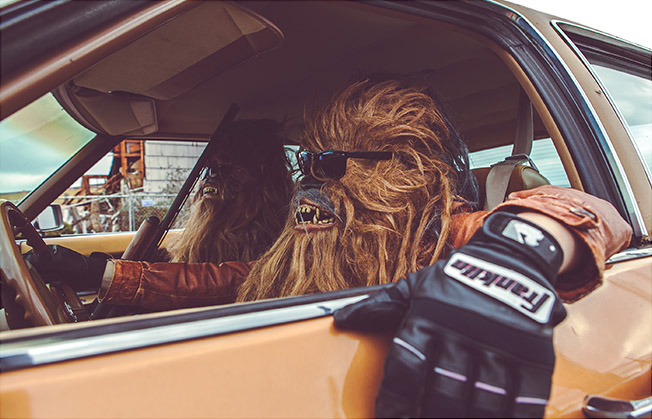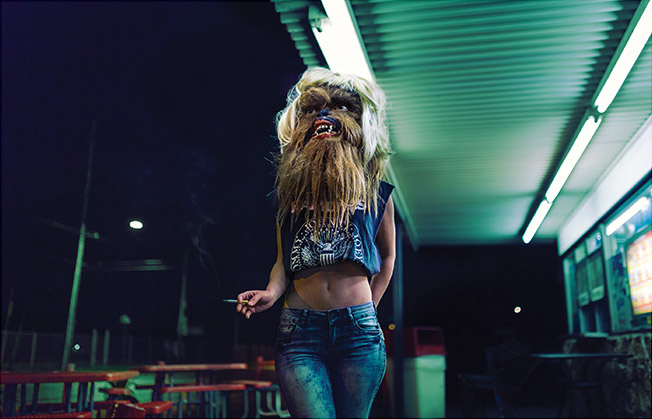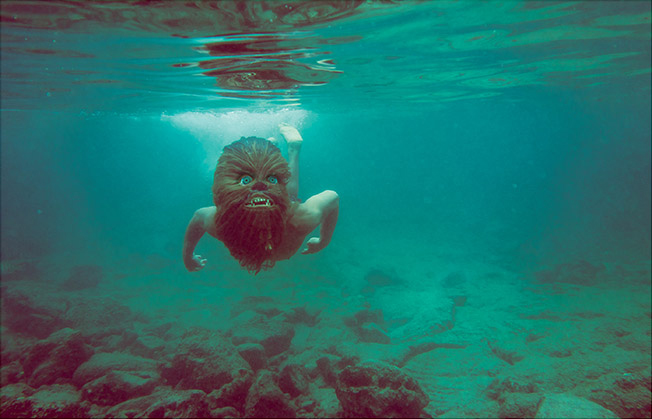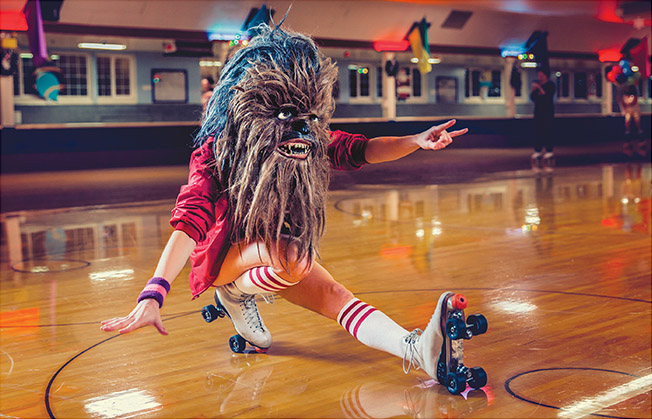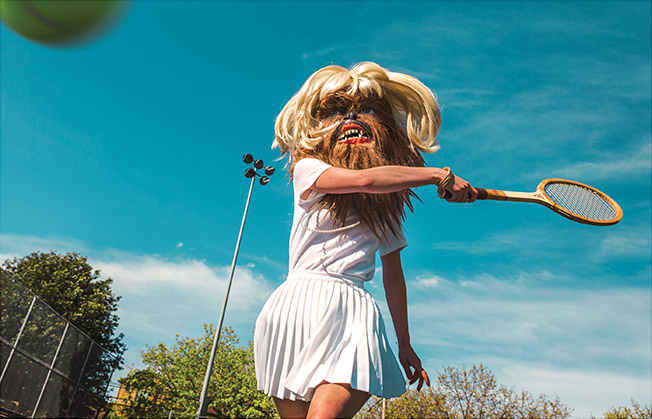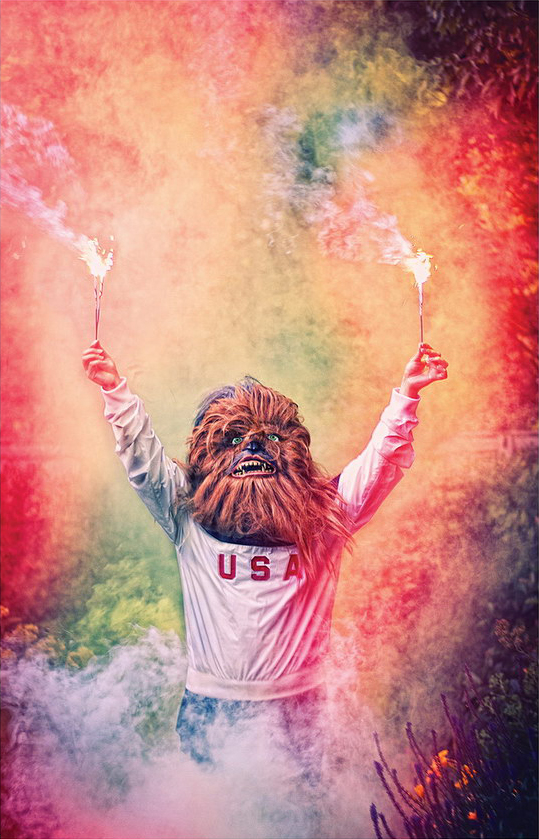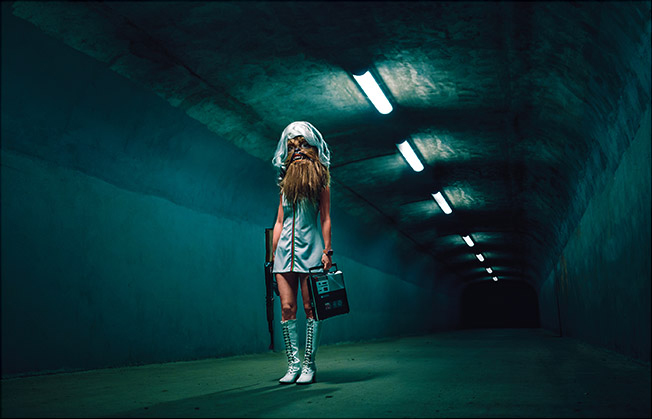Preview: Mako Miyamoto – Speculative Hunting @ Gauntlet Gallery [SF]
The oregon photographer continues his “neon werewolf” series involving striking, nostalgia-evoking cinematic images, rich, deep color palletes, & wookiee heads.

Right here — what you’re currently reading, I mean — is the beginning of the post and the section where I typically like to come in and try to slap out whatever “deeper” context I’m feeling about whatever artist/artwork I’ll be posting examples of toward the bottom. I like to feel all sorts of ways about things and jabber on about them… hence, this whole website thing. Sometimes, I’ll see something from a slightly different perspective, or simply something beyond what’s presented through one sheet press releases. I definitely believe that there are a lot of artists out there who probably invest too much of an effort into pretentious artist statements attempting to explain the importance and deep emotional nature of their work in lieu of simply crafting work that generates and triggers those emotional responses organically and without any need for explanation. On the other hand, I also believe that sometimes those feelings can be translated into words, which can help shine a light on some ideas that might even lead to a greater understanding of what we’re feeling and how we exist in relation to our experiences, maybe even the world at large. And then, of course, there are times that I see something and am immediately drawn to it, simply because it just looks really fucking awesome. Not to discount that there is any further appeal or substance behind his work, but the photography of Portland-based artist, Mako Miyamoto… it looks pretty fucking awesome.
Miyamoto‘s new solo exhibit, Speculative Hunting, opens tomorrow night (April 25th) at San Francisco‘s Gauntlet Gallery and shows him continuing to explore his “Wookie-themed” photographic series, ‘Neon Werewolf.’ So, what does this series entail? It basically consists of images where the subjects are wearing elaborate full-skull wookiee masks while being engaged in various random activities that range from busting moves in a skating rink to participating in an oceanside martial arts battle, complete with the glistening sand and rolling tide backdrop. And while some of the photographs do connect to each other directly, creating broader storylines and presenting particular narratives that unfold chronologically throughout the course of a handful of images — one group of shots involves an armed heist going awry — and although there is an undeniable absurdity presented by focusing on humanoid figures with the heads of a fictional race of woodland space creatures, the images are still very striking on their own and can thrive independently of one another. The high contrast and rich, deep colors in the photographer’s work are reminiscent of the bold, emotionally stirring visuals from David Lynch‘s photographic work, as showcased in his Dark Night Of The Soul project. Not unlike the remarkably affecting quality that Harmony Korine managed to conjure up with the magnificently visceral (and incredibly polarizing) Spring Breakers, Mako ventures into similar emotional territory, even utilizing some similar mood lighting. Whether it’s neon signs and stray convenience store fluorescence beaming onto a parking lot at night, or cerulean clouds at dusk over the dark, wet beach, that very distinct, yet indescribable feeling that only such environments can truly generate breathe through these photographs, imbuing them with a tangible life.
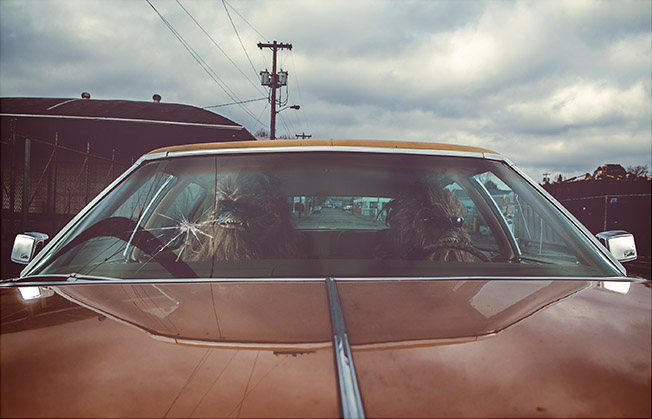
So what’s the deal with everyone rocking those fucking Chewbacca heads? “How does such base wackiness play into the art and benefit it, rather than detract from it?” you might ask. It’s an interesting question, with the truest and simplest answer being that, along with exhibiting some additional movement to the characters, they really just add to the overall compositions and aesthetics of these pieces. Or, as it was put previously, “they look pretty fucking awesome.” But a slightly more thorough explanation of why I believe that some of these images have the ability to connect as they do, benefited by the inclusion of these mangy headpieces, relies on Mako‘s artistic awareness and tasteful balance, which involve him infusing the work with a nostalgic quality without relying too heavily on that aspect to carry the pieces, entirely. On paper, throwing a Chewbacca head on a subject to take photos seems a bit low brow — in respect to both humor and art — something you might do with a friend at a slumber party, but nothing anyone would actually ever attempt to peddle as fine art and promote as if it had any additional worth. And to continue with the brutal honesty, in the world of underground, pop-culture-driven art, which has become so prominent over the last decade or so, it really has, unfortunately, far too often, become as basic and unoriginal as painting a straightforward picture of an action figure, which is an easy sell for people hooked on geek culture that require nothing more than the reference made to their youth. The real problem is that these interpretations/tributes don’t actually even have to be very good — just a drawing of something that you recognize; an initial concept that the artist didn’t even create or modify other than the medium (and, often times, not even that much).
By Miyamoto only using the heads of non-specific wookiees, rather than their entire bodies or an environment that relates to the characters, there’s a sly throwback to that emotional reference point and the emotional nostalgic quality, without becoming overly overt. The washed-out tone and color palates used in much of the work provides a late 60s – early 80s retro vibe, as do additional elements like the clothing (wristbands, striped knee-high socks, a satin jacket, light-brown leather jackets, a pleated tennis skirt, and white go-go boots and mini shift dress ala Nancy Sinatra) and the activities which they are participating in that relate to such gear and were more prominently associated with those times. Of course, the vague Star Wars component plays into that era and feeling, as well. The reason that it works is because the photography itself is good enough that, without the masks, the images would still operate as beautiful cinematic stills, but these wooly heads allow for the shots to retain that quality, without allowing the identities of the individuals to conflict with the viewers absorption of that emotional quality directly. In this form, there are merely quick reference points to a more general time and space that bleed into one another. An while I see the value in presenting these photographs in small groups that connect as evolving narratives, I actually appreciate them more on their own individual merits. For me, there is strength in the fact that the photographer manages to create images bigger than their physical dimensions, outgrowing their frames. Also every shot has some sort of movement to it, whether it be physical or narratively — they naturally prompt the questions about what led to that frozen image and what must be coming next, allowing the viewer’s mind to mock up that space in their own heads. One power of the otherwise aggressive looking masks is that, by stripping that human identity, the only option is to focus on the emotion of the subjects. Much like the Kuleshov effect demonstrated by Russian montage filmmakers who operated in the first half of the 20th century by relying on stock images to be interpreted by their surrounding context — a young wide-eyed girl with her mouth ajar could be read as anything from terrified or excited to struck with disbelief and awe, depending on what type of film and moment the frame was utilized for (a birthday party, an air-raid, etc) — these masks can be viewed as anything from menacing to comical, based around the envrionment and framing; Miyamoto even attempts to use them femininely. Another way that these beastly domes drive the work and help the photos expand beyond more standard restrictions is that they naturally suggest an alternative, yet parallel, universe that is inhabited primarily by this foreign species; a suggestion that automatically infers a broader emotional scope for these creatures, beyond what one might expect from “a guy in a monster mask” — logic would implicate that there are complexities and variance among any race (it’s tragic that far too many don’t seem to be aware of that in our own world, but I digress).
So… there you have it; I seem to have slipped into reading too much into a collection of photographs featuring characters wearing wacky masks that, at times, is even pushing out some heavy Teen Wolf vibes, but it’s interesting to examine why I genuinely feel something from Mako‘s images and dismiss so many others playing the jokey and/or nostalgia card; not everyone can just slap a mask on a subject and create something that feels of authenticity and value. It’s a line far too easy to cross over unchecked and very difficult to balance, which is the reason that pioneers like Robert Williams have openly questioned the quality control involved throughout the alternative art world that he did so much to pioneer. For Miyamoto, the key is both the fact that he has a great eye for the technical elements like composition and color, and that he is able to juggle that delicate balance between fantasy and realism, while filtering it through something as powerful as nostalgia and simultaneously injecting it with something fresh enough to feel otherworldly. While those working in hyper-realism work to paint and/or illustrate pieces that appear like photographs, Mako is presenting photographs that possess the surreal dreamlike quality of a painting. There’s a vague familiarity being showcased in Speculative Hunting that allows us to understand the photography in an emotional manner that, for various reasons, should probably never need to make much sense intellectually, and I believe that’s what makes it art and that’s what makes it work; or, at least, that’s what makes it those things for me. And if all of that just sounds like a load of jive ass bullshit, Mako Myamoto‘s new photography exhibit still looks pretty fucking awesome. So.. it has that going for it.
Here’s a little something more about the artist and his work via the press release
Mako Miyamoto is a Portland-based photographer whose Wookie-themed ‘Neon Werewolf’ photographic series explores popular culture themes amidst the guise of a pop-culture icon. Placing human characters in a variety of familiar contexts and scenarios, Miyamoto uses the mask to explore human emotion; and reveals a wonderful depth of expression in his subjects – all through a veil of shaggy hair. His direction of each series of photographs is as cinematic as the principal character itself and contains a welcome level of humor; location specific, planned and storyboarded, and partly improvised with his subjects and collaborators during each shoot.
The exhibition will feature 20 photographic works – each available in two physical and edition sizes.
About Mako Miyamoto
Mako Miyamoto was born in Gold Hill, Oregon in 1980. He has previously lived in Eugene, Oregon; San Francisco, California and now resides in Portland, Oregon where he holds a post of Creative Director for Roundhouse Agency. Mako has previously exhibited his work in solo exhibitions at White Box Gallery and Gallery 135, and his photography has been featured on the Huffington Post, ABC News, Daily Mail, New York Daily News, Laughing Squid, PetaPixel, Yahoo, MSN Photos and My Modern Metropolis amongst others.
He holds a BFA in Multimedia Design from the University of Oregon, and subsequently pursued photography as his principal art-form where he found that he enjoyed capturing the world around him, and with his camera he could bring some of the magic, mystery, and monsters back into the world he loved so much as a child. When people look at his photos, he wants them to feel that magic again. Speculative Hunting is his first solo exhibition in San Francisco.
Check out preview images for the exhibit below the following event details…
WHAT:
Speculative Hunting
photo exhibit by Mako Miyamoto
WHEN:
Opening:
Saturday, April 25th
7:30pm-10pm
WHERE:
Gauntlet Gallery
1040 Larkin St,
San Francisco, California 94109
ADDITIONAL INFO:
Opening is ALL AGES w/NO COVER
Show on view until Saturday, May 16th
Gallery hours: Tues – Sat. noon – 6pm
Facebook Event Page: https://www.facebook.com/events/1417159711934235/
